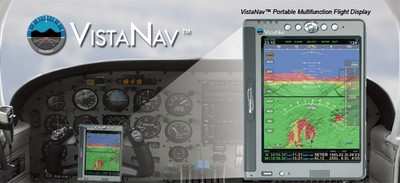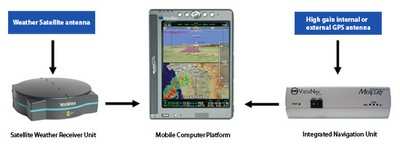Sun, Mar 05, 2006
 Mercury Computer Systems, Inc. has
released VistaNav version 1.5, its multi-function flight display
system with synthetic vision technology. This latest release of the
VistaNav system integrates XM satellite weather information
including NEXRAD Precipitation and Cloud information, Live TFRs,
METAR Flight Rules Indicators (FRI), as well as detailed METAR and
TAF text information.
Mercury Computer Systems, Inc. has
released VistaNav version 1.5, its multi-function flight display
system with synthetic vision technology. This latest release of the
VistaNav system integrates XM satellite weather information
including NEXRAD Precipitation and Cloud information, Live TFRs,
METAR Flight Rules Indicators (FRI), as well as detailed METAR and
TAF text information.
The VistaNav system provides the pilot with a complete portable
navigation solution including 3D Synthetic Vision,
Highway-in-the-Sky (HITS) Flight Path Guidance, 3D Terrain Views
and 3D Approach Display. In addition to its synthetic vision
features, VistaNav can display 2D navigation in either full or
split-screen formats.

"Adding XM weather to VistaNav’s three-dimensional
synthetic vision provides the pilot with a complete, portable
navigation solution and greatly enhances their ability to negotiate
both terrain and weather in challenging flight conditions," said
Philippe Roy, Director of the Visualization & Simulation Group,
Commercial Imaging and Visualization, Mercury Computer Systems.
"This combination of advanced 3D visualization technology and
state-of-the-art inertial navigation hardware delivers
unprecedented situational awareness to pilots in a portable cockpit
solution."

The VistaNav system includes an INU (Inertial Navigation Unit)
featuring 3D solid-state inertial sensors, a WAAS-enabled (Wide
Area Augmentation System) GPS receiver, and a Bluetooth®
wireless interface. The unit can be mounted in a number of places
inside an aircraft and communicates through a wireless interface
using a tablet PC mobile computing platform (MCP). The MCP has a
high-resolution 5"x 8" LCD display with a full navigation user
interface that allows pilots to manage all phases of flight, from
preparation to parking. The entire unit is powered by the aircraft
power supply and includes rechargeable batteries that will operate
for up to one hour in the event of an aircraft electrical failure.
Both the INU and MCP are designed to be removed or installed in an
aircraft in less than three minutes.
More News
Have A Story That NEEDS To Be Featured On Aero-News? Here’s How To Submit A Story To Our Team Some of the greatest new stories ANN has ever covered have been submitted by our>[...]
“The legislation now includes a task force with industry representation ensuring that we have a seat at the table and our voice will be heard as conversations about the futur>[...]
Aero Linx: Waco Museum The WACO Historical Society, in addition to preserving aviation's past, is also dedicated and actively works to nurture aviation's future through its Learnin>[...]
Adcock Range National low-frequency radio navigation system (c.1930-c.1950) replaced by an omnirange (VOR) system. It consisted of four segmented quadrants broadcasting Morse Code >[...]
Also: uAvionix AV-Link, Does Simming Make Better Pilots?, World Games, AMA National Fun Fly Czech sportplane manufacturer Direct Fly has finished delivering its 200th ALTO NG, the >[...]
 ANN FAQ: Submit a News Story!
ANN FAQ: Submit a News Story! Aero-News: Quote of the Day (06.12.24)
Aero-News: Quote of the Day (06.12.24) ANN's Daily Aero-Linx (06.12.24)
ANN's Daily Aero-Linx (06.12.24) ANN's Daily Aero-Term (06.12.24): Adcock Range
ANN's Daily Aero-Term (06.12.24): Adcock Range Airborne Affordable Flyers 06.06.24: 200th ALTO, Rotax SB, Risen 916iSV
Airborne Affordable Flyers 06.06.24: 200th ALTO, Rotax SB, Risen 916iSV





